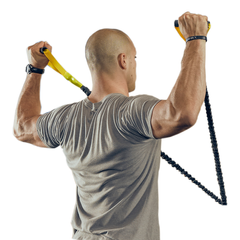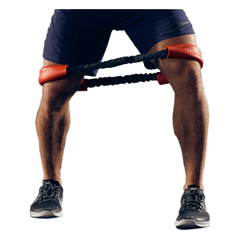Previously in
The Movement #240, we opened up a mini-series on tendons—
the hardworking yet sometimes sensitive tissues that connect our muscle to bone.
This week, we'll cover
the spectrum of changes presented by Jill Cook and Craig Purdam in
2009 (and updated in
2014) that lead to stiff and painful tendons or something worse if we ignore them.
Starting With The Good
The spectrum starts with the tendon's ability to thrive under the right amount of stress.
When we move, run, or lift, tendons experience micro-stresses that prompt them to become more robust and capable of handling the demands we place on them.
However, building strong tendons is about more than just making them bigger. It's also about optimizing their spring-like structure.
Structured and progressive training of our tendons:
-
Increases Collagen Production: Tendon cells respond to mechanical load by increasing collagen synthesis, especially type I collagen, the main structural protein in tendons.
-
Improves Collagen Alignment: With loading, the collagen fibers within the tendon tend to become more organized and aligned, like a steel cable.
-
Enhances Cross-Linking: Training encourages the formation of cross-links between collagen fibers, which strengthens the tendon.
-
Increases Tendon Stiffness & Elasticity: Training increases the tendon's stiffness. This might sound bad—since we don't want to be "stiff"— but it's actually beneficial because stiffer tendons store and release energy more efficiently.
These changes are essential for the tendon's unique spring-like ability, which stores and releases energy, allowing us to move efficiently for high-powered activities like running, jumping, and quickly changing directions.
When It Goes Bad
There are three primary stages in the progression of tendinopathy:
Reactive Tendinopathy
When tendons experience a sudden increase in load—maybe from ramping up your workout or jumping headfirst into a new activity—the tendon cells respond by increasing protein production, resulting in a stiff and thickened tendon as it attempts to adapt to the load.
With reactive tendinopathy, pain usually develops quickly, often within hours to a day, making the onset easy to link to a recent change in load.
With appropriate load management (i.e., backing off intense activity and allowing time for the tendon to adapt), reactive tendinopathy has a good chance of fully reversing without permanent structural changes.
Tendon Disrepair
If the loading persists without allowing for adequate recovery, the tendon structure starts breaking down and becomes much more disorganized.
The tendon cells ramp up their activity even more, producing more collagen and other proteins to repair the damaged tissue. However, this response often outpaces the tendon's ability to organize and integrate these proteins into a strong and functional structure.
This disorganization weakens the tendon and makes it less effective at handling loads.
Unlike the uniform thickening in reactive tendinopathy, the disrepair phase often results in more irregular swelling or localized nodules within the tendon.
Additionally, new blood vessels start to grow within the tendon. While this might seem beneficial, new nerves often accompany it, which is believed to increase sensitivity and contribute to the chronic pain associated with tendinopathy.
Unlike reactive tendinopathy, which has a good chance of fully reversing with rest and load management, tendon disrepair is more challenging to reverse.
But, with some targeted work, like eccentric exercises, there is a high potential for drastic improvements.
Degenerative Tendinopathy
This stage represents the end of the tendinopathy continuum.
It is marked by chronic degeneration, with large areas of disorganization, cell death, and a limited capacity for the tendon to heal or adapt. This creates a compromised structure that can no longer effectively take on loads and is highly vulnerable to tearing.
The tendons often display further blood vessel and nerve growth, making the tendon more painful even with minimal loads. Or, confusingly, in some cases, the nerve supply becomes irregular, making the degeneration pain-free.
This reveals the complexity of pain in tendinopathy.
It's not always painful, and a considerable portion of the population lives active, pain-free lives despite a chronic tendon issue.
Notably, at this stage, the structural changes in the tendon are considered irreversible. Strengthening exercises can help improve function and mitigate pain, but the tendon is unlikely to return to normal.
Instead, treatment aims to optimize the function of the healthy portion of the tendon rather than attempting to reverse the degenerative damage.
What This Means for You
An understanding of this continuum highlights a few important points.
-
Listen to your tendons when they start talking to you. Scale down your training, switch things up, and get serious about your corrective work! Pushing through might feel heroic, but it can push you further down the continuum.
-
The development of tendinopathy doesn't happen overnight, so don't expect healing to happen that way, either. Rehabilitation of a chronic tendon issue can take many months or even years to resolve. Be patient and stay consistent.
- You become more susceptible to degenerative tendinopathy as you get older, and it might not always present itself with pain. That makes focused work on tendon health vital as we age.
The good news?
With ongoing work, many tendons can move back up the continuum toward healthier, more resilient tissue.
Stay tuned as we continue this exploration next week.
We'll dive into targeted strategies to keep tendons healthy at every stage so you can keep doing what you love without interruption.
 Shoulder Packages
Shoulder Packages
 Hip & Core Package
Hip & Core Package
 NEW - Crossover TORQ
NEW - Crossover TORQ
 Bundles
Bundles
 Accessories
Accessories
























